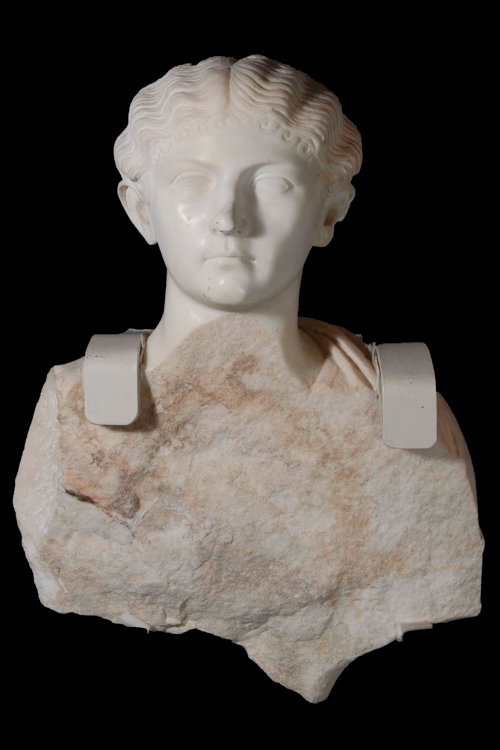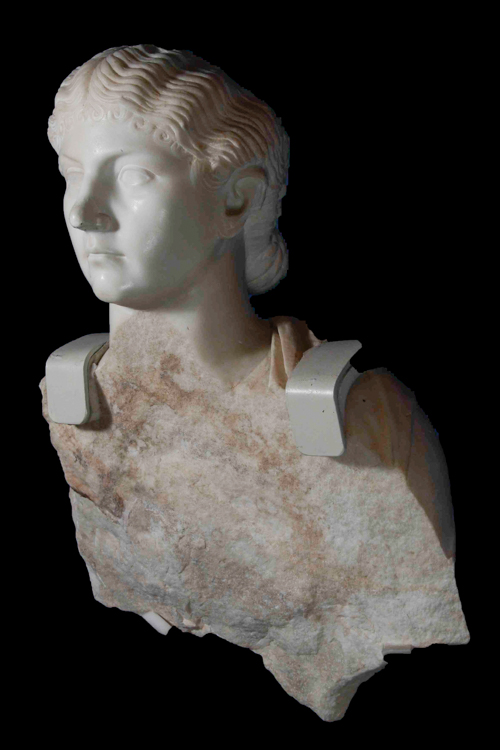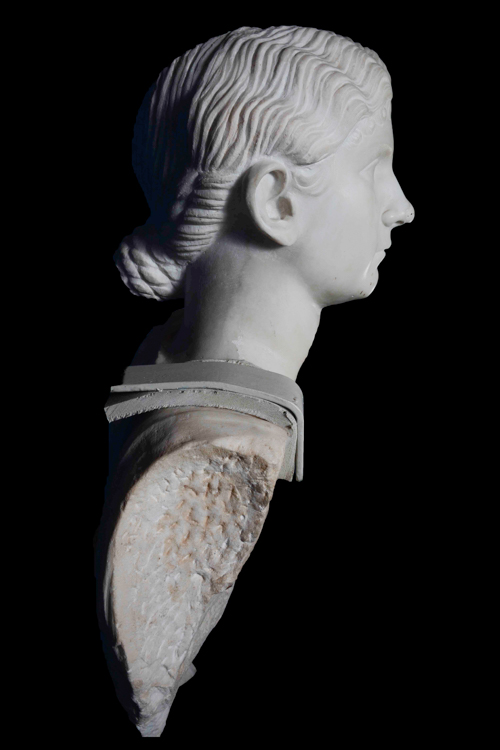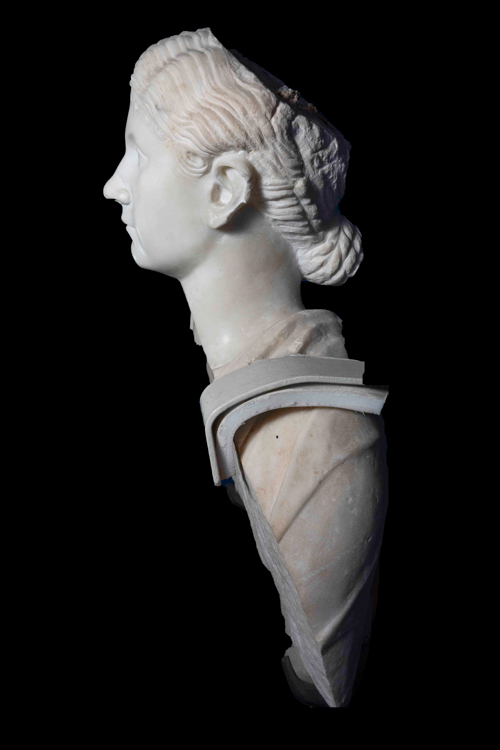I.D. no: 15882
Dimensions: Max. H. 60 cm; Max. W. 22 cm.
Material: Very fine grain white marble (identical to that of the Lower Draped Torso, I.D. no 15886)[1]
Provenance: The 1881 excavations of the Roman Domus in Rabat, Malta
Current location: Domvs Romana Museum in Rabat, Malta
Condition: The lower part of the upper torso is missing sparing only the head and the bust. A huge part of the front is also missing, resulting from a deliberate break affecting the whole bust from the neck down, depriving it of the whole intervening midriff section. The right shoulder, together with the rest of the arm, is also missing, but this was attached separately and held in place by an iron dowel. Another straight cut deprives the head of its crown: traces of five iron nails on the surface of the cut indicate that this part was also attached separately. The missing tip of the nose is restored in plaster. Small chips are visible on the left ear and on the drapery. Possible traces of painted irises survive on the otherwise plain eyeballs.
Description: Unlike its companion statues from the same provenance, the head of this portrait statue, together with the rest of the upper torso, are carved in a single piece of marble. Together with the missing section of the midriff, the bust was almost certainly inserted into the hollow cavity at the top of the Lower Draped Torso (I.D. no 15886) of this catalogue.[2] The head belongs to a beautiful young lady in her late teens or early twenties, with fresh, young facial features. Her face has the triangular shape and other features (like the somewhat splayed ears) typical of the Julio-Claudian family. The eyes are not set very deep in their sockets and the eyeballs are rather flat.
The lady wears a very characteristic hairstyle, also typical of the female members of the Julio-Claudian family. Her hair is parted at the centre above the forehead and is swept sideways in wavy strands that pass over the ears beyond which they are plaited into braids and collected at the back in a chignon and bun over the nape of the neck. Seen from the back the crown of the head is covered by a shallow mass of hair which is framed by the bun itself and the lightly plaited bands leading to it from behind the ears. The ears are left completely bare. The forehead is framed by a row of ten shallowly carved, cork-screw locks, five on either side of the central parting and oriented symmetrically towards the centre. A semicircular loop hangs down in front of each ear.
Discussion:
The physiognomy of this portrait leaves no doubt that it represents a female member of the Julio-Claudian family. The circumstantial and contextual evidence surrounding it, however, tends to close the circle of eligible candidates to immediate members of the family of Claudius, emperor between AD 41 and 54. The main contender in the respective literature has been for almost a century Antonia the Younger (36 BC-AD 39), daughter of Marc Antony and Octavia, wife of Drusus the Elder and mother of Livilla I, Germanicus and Claudius.[3] Both the characteristic physiognomic features of the face and the hairstyle are reproduced in a considerable number of female portraits which have been assigned to the beautiful mother of Claudius and classed together by Polaschek under one type, the “Typus Malta-Leptis”.[4]
Assigned to Agrippina the Younger by Ashby, followed by Zammit, this portrait was attributed to Antonia Minor by Pietrangeli soon after.[5] This identification appeared to be supported by the portraits of Antonia on coins struck in the reign of Claudius.[6] One of the coins, minted in Alexandria, portrays her with a single row of ringlets on the forehead.[7] The beautiful portrait in Berlin is very similar to the Maltese one, and both seem to represent a princess in her younger years.[8] But her face is sweeter, the facial bone structure much less strongly pronounced. The Maltese head has even closer analogies in the fragmented head of Palermo,[9] and in that of Cherchell,[10] while the head from Leptis differs from the others in having more than ten ringlets on the forehead.[11] On the other hand, it is almost identical, both typologically and stylistically, to the portrait statues of the same young lady in Cherchell and Grosseto (from Rusellae) which go a long way to confirm the suggestion made above that the Rabat bust must have originally been part of a draped statue of a closely similar typology.[12] In fact, the lower half of the Cherchell statue is almost identical to the separate lower half of a draped figure from the same Rabat domus (I.D. no 15886) and the likelihood is that the missing front of the latter was identical to that of the former except that the himation crossed from the back to the front on the left shoulder in the Maltese bust and on the right shoulder in the statue from Cherchell. On the other hand, both statues had the whole of the right arm added separately, which might mean that both carried the cornucopia on the right arm, which would qualify them both as personifications of Tyche/Fortuna, as suggested by Landwehr.[13]
Similarly, another full statue with approximately the same drapery format was discovered in the thermae of Cemenelum.[14] Its head bears a strong resemblance but she is more advanced in age, portrayed as Augusta wearing a diadem,[15] and her hairstyle lacks the ringlets on the forehead and has two wavy strands falling on each side of the neck behind the ears. Her identification with Antonia was confirmed by an integrated fragmentary inscription.[16]
Taking into consideration all the above, however, we have to reconcile the very young age of the Rabat head with the advanced age (75 years) of Antonia Minor before she died in AD 39, that is, before Claudius’ accession to the throne. An idealized, exaggeratedly youthful, even if posthumous, portrait is hardly conceivable in the Rabat Claudian cycle of portrait statues even though she appears with such youthful features, but wearing a queue and without curls on the forehead, on a dupondius issued by Claudius.[17] By the same argument, mature members of Claudius’ female relatives, like any of his wives, are excluded.[18] This would also exclude Caligula’s sister Iulia Livilla (born in AD 18 and exiled and murdered in 41/42) who has also been proposed for some of the closely resembling portraits, such as the Cherchell and Rusellae portrait statues.[19] So other, more plausible, candidates need to be sought, possibly among his daughters.
In this search Claudius’ undoubted portrait restricts us to a relatively short time span of thirteen years, those of his reign, namely, from 41 (the year of his accession to the imperial throne) and 54 (the year of his demise). Of his two children by his first wife Urgulanilla, Drusus had died prematurely and Claudia had been disowned. On the other hand, his daughter by his second wife Aelia Paetina, Claudia Antonia, was integrated in Claudius’ court and she is portrayed more than once, together with Claudius’ other children, on the provincial coinage.[20] Born certainly before Claudius divorced Aelia Paetina and married Messalina in 39/40,[21] Claudia Antonia would have been in her late teens or early twenties in 49-50, the date postulated for the Malta statue cycle.[22] She was executed by Nero in AD 65 after her refusal to marry him and her involvement in the conspiracy of Piso. After the latter episode, her images would have been condemned to memory and removed from public display. On this account her portraits are difficult to identify and none seem to have been attributed to her with any degree of certainty.[23] If we had to exclude any posthumous attributions – from the likelier, like Antonia Minor, to the less likely, like Iulia Livilla – the person that would fit best with this portrait in terms of age, physiognomy and relationship with Claudius, is his daughter Claudia Antonia.[24]
This very fine portrait from the Roman Domus of ancient Melite is a very accomplished piece of plastic art and constitutes one of the best known and cited images of this Julio-Claudian lady. It displays a lucid and somewhat descriptive construction of the very characterized physiognomy but it is still heavily influenced by the neo-Attic idealizing current of the Augustan age, in contrast with the much warmer and colouristic head of Claudius from the same context.
Date: probably around AD 50.
Bibliography: (previous publications of item): Caruana 1881: 7, pl. without number at end of booklet: “white marble bust, of inferior workmanship, representing a female, its nose broken”. Ashby 1915: 39, fig. 10: “fine portrait bust in close-grained marble, 1 foot 8 inches high, of the type of Agrippina the younger”. Zammit 1930: 21 and pl. without number: repeats the attribution to Agrippina the younger, but adds more descriptive details. Pietrangeli 1938: 55, 102 (Antonia Minor). Poulsen 1946: 26, no 3. Felletti Maj: 1953: 54, no 85 (Antonia Minor). Harrison 1953: 24, pl. 44a. Leglay 1957: 37. Poulsen 1962: 78, no. 3. Bonanno 1971: 117-121 (Antonia Minor). Polaschek 1973: 39-40, no 64, and passim, pls. 19,1-2, 20,2, 21,1 (Livilla). Bonanno 1992: 22, note 60, pl. 28 (Claudia Antonia). Bonanno 1997 (Claudia Antonia). Rose 1997: 68-69. Bonanno 2005: 221 (Claudia Antonia).
[1] Identified as probably Pentelic by L. Lazzarini (personal communication 24.02.04). On 14.10.1989, Susan Walker identified this marble as Carrara.
[2] For the arguments in favour of this attribution see Bonanno 1992, 1997, and the entry for the Lower Draped Torso (I.D. no 15886) of this catalogue.
[3] For Antonia Minor see Groebe 1894, and the monograph dedicated solely to her by Kokkinos (1992). For her portraiture see Felletti Maj 1958: 441; Fittschen 1977: 58-62, nos 18-19 (after Bernoulli 1886: 217-230). Poulsen (1946: 24-32) made the first valid contribution towards the reconstruction of the iconography of this imperial lady and he considered the Maltese portrait, together with the head in Berlin, as copies of an early portrait “used on later occasions in her life or even after her death”. Felletti Maj (1953: 54, no 85) derived the Rabat marble, together with those of the Museo Nazionale of Rome, Leptis, and Cherchell, from a single original but was in doubt whether to accept the identification with Antonia. Most scholars have identified her with Antonia Minor, fewer with Livilla (either I, sister of Claudius, or II, sister of Caligula). The majority of the latter, however, fail to distinguish which Livilla they have in mind or, when they do, they do not take into consideration her respective age. See, of late, Landwehr 2008: 50-51, note 1 (signed by A. Alexandridis).
[4] Polaschek 1973: 39-45 who, however, attributed it to Livilla I, Claudius’ sister (p. 45). In his study of the development of female hairstyle in the first century of the Roman Empire, Fournèe van Zwet (1956) had already expressed some reservations on this identification (p.2, nos 29-30). Nevertheless, in her appendix dedicated to female portraits with bare-headed, but otherwise undetermined, group, Alexandridis (2004: 213) adopts the identification with Livilla (“Typus Leptis-Malta) while including the Berlin portrait (see further down) in a separate group assigned to the “so-called Claudia Octavia” (p. 214).
[5] Ashby 1915: 39; Zammit 1930: 31; Pietrangeli 1938: 55, 102.
[6] See Polaschek 1973: 15-18, with previous bibliography. See also Giacosa (no date): 24-25, pl. 7.
[7] Bernoulli 1886: pl. 33, no 12, This hairstyle is closely imitated in a portrait of an old woman from Ostia: Calza 1964: 39, no. 47, pl. 28.
[8] Blümel 1933: 11, R23, pl. 16; Bianchi Bandinelli 1950: 118, pl. 48, figs 93-94; Harrison 1953: 24, pl. 44a.
[9] Bonacasa 1964: 60-61, no 74, pl. 34, 3-4, although he associated the Maltese portrait with his cat. no. 73, pl. 34, 1-2.
[10] Landwehr 1993: 89-90, cat. no. 66, pls 94-95; Landwehr 2008: 50-51, pl. 31. Apart from the portrait in the Vatican Ingresso Inv. 103 (Polaschek 1973: pl. 20,1), the only other portrait which displays a bun (or chignon) at the back rather than a knot, like the Maltese specimen, is that from Caesarea Mauritania (Cherchell). Another identical portrait head, but of unknown provenance, is that from Spoleto: Sensi 1987: 14-17, no. 7, pls 5, 23 (Livilla I).
[11] Aurigemma 1940-41: 88, figs 65-66; Bianchi Bandinelli 1964: pl. 98.
[12] Leglay 1957: 34-35; Landwehr 1993: 89-90, no 66, pls 94-95. Grosseto, Museo Archeologico della Maremma, inv. No 97740.
[13] Landwehr 1993: 89-90.
[14] Where it must have been transferred in the Severan period. Now in the Museum of Archaeology of Nice-Cimiez (Mouchot 1989: 88-89).
[15] At 2.10m high, she is even larger than life-size.
[16] (Antonia Augusta) M(arci) F(ilia) Cla(udi Neroni Drusi uxor). Benoit 1966: 376.
[17] Giacosa, no date, pl. 7.
[18] See the identification of the draped female figure in the same Rabat cycle (I.D. no 15888) in this catalogue.
[19] Such as Polaschek 1973: 44-45; followed by Boschung 1993: 63-64; Boschung 2002: 190-91 notes 1382, 1385. Rose 1997: 68-69; Varner 2004: 102 (full list, including the Malta bust, in note 167).
[20] On the reverse of a silver didrachm of AD 41-48 of Caesarea in Cappadocia (BMCRE 1, 199, no. 242, pl. 34, fig. 8), the other two being Messalina’s children Britannicus and Claudia Octavia; and of another coin from Cappadocia (BMC Cappadocia 46, no. 13, pls. 8,8), where she appears with Claudia Octavia.
[21] Probably before AD 30, since she was married to Cn. Pompeius Magnus in AD 41 (PIR1 P 477).
[22] On the other hand, her half-sister Claudia Octavia, having been born in 41, was far too young in Claudius’ lifetime to fit with the age of this bust. She eventually married Nero, and was later banished and executed on his orders.
[23] Rose 1997: 72 (Antonia III); Varner 2004: 101-2.
[24] For her identification with the diademed princess as Venus Genetrix on the San Vitale frieze in Ravenna, see Meyer 2000: 48-54.




